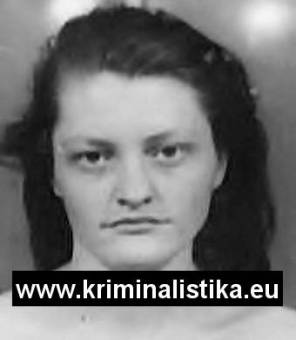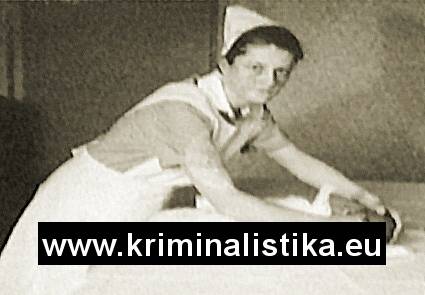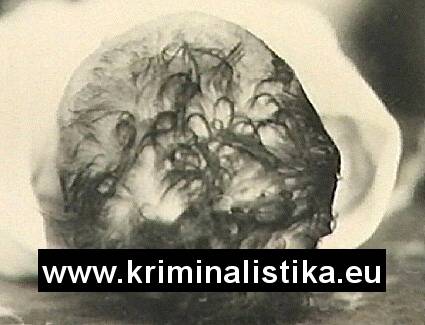Marie Fikáčková
Born on September 9th, 1936, Sušice - executed on April 13th, 1961, Prague

A twenty-four-year old nurse, Marie Fikáčková, is arrested right at the maternity ward of the Sušice District Hospital on February 27th, 1960. Two newborn babies, girls, die while she is on duty on February 23rd, 1960. The autopsy proves that a serious brain injury was the cause of death of the two newborn babies. One of them has even broken arms.
The questioning starts on February 28th, 1960 and takes nearly six hours. After midnight, Fikáčková spontaneously pleads quilty. It is February 23rd, 1960 and she crushes the head and breaks arms of the only twenty-hour old newborn baby right at the maternity ward. She wounds to death that way a five-week old baby the very same day. She says she attacked ten more newborn babies before. They are said to survive.
The local people are taken aback. Fikáčková is known to be a decent woman and a hard working nurse. There goes a rumour about the number of murdered babies and the way the babies were wounded. Some people even speak about stabbing needles in the eyes and heads of the newborn babies. Although there is no evidence, the nurse is said to be responsible for every baby who has died recently.
Marie Fikáčková is born to a rather poor family who declare their support for German nationality. Her father is a violent person and a heavy drinker who hates the Czechs. She does not relate to her mother either. They quarrel very often. On the other hand, she does very well at school. In 1955, Fikáčková successfully passes the leaving examination at the Secondary Medical Service School in Klatovy. She becomes a nurse at the District National Health Centre in Sušice the same year. She starts working at the maternity ward in October 1957. She seems to like her job there. When being questioned by Police, she says she used to be tortured by her mentally affected brother. She mentions her violent neighbour, too. When committing the crime, she is married, but childless. She is even about to be promoted to a head nurse.
Crime reconstruction: Fikáčková wounding the newborn baby

Her motive? She hates crying babies. She tells flat: "I was trouncing the babies right before or during my periods only. Crying babies drove me crazy and my hatered of them even grew." The medical experts find Fikáčková to be a person with hysteria and blow-up tendencies which are beyond her control. But, when committing her crime, she is sure to be completely sane. She says she would even hit her own child if it cried very often.
It means she attacks only crying babies who cannot be calmed down. She trounces the newborn babies under the attack of hysteria. She says: "When I was pressing little Prosserová's head, I could feel my fingers sinking into it. I did not feel any skull cracking at that time. I was just pressing the little head and my fingers got deeper and deeper. My anger faded away after a while and I could continue working."
Police have to make sure that Marie Fikáčková has not murdered some more newborn babies. They check the whole collection of the handwritten medical documents, the work schedules and the autopsy records, but they do not find any other strange death of a newborn baby. Nevertheless, the medical documents write on two newborn babies who suffered an injury when Marie Fikáčková was on duty. The babies are thought to be injured while changing or weighing them. Those injuries are explained when Fikáčková pleads quilty. She is accused of those crimes too.
Marie Fikáčková is sentenced to death on October 6th, 1960. It is almost eight months after her being arrested. Her solicitor appeals from the judgement twice, but the sentence stays the same. The execution itself takes place in Pankrác prison on April 13th, 1961, early in the morning.
In 2007, the yellow press infirms the real number of newborn babies who died after her attack. Some journalists labels her "the present greatest serial killer". They are sure there were at least ten more victims of hers. She is also said to be responsible for a lifelong suffering of many more newborn babies in a form of inadequacy resulting in an early death. But there is neither direct nor circumstantial evidence for their opinion.
Infectious infantile paralysis causes the death of lots of newborn babies, infants and little children at that time. The medical statistics say that every twelveth child dies of that disease in the early 1950s. The last infectious infantile paralysis pandemic, which repeats every three or five years, breaks out in Czechoslovakia in 1957. Fikáčkova becomes a nurse at the maternity ward in Sušice the very same year. The yellow press says Fikáčková murders the very first newborn baby in 1957, but the baby is highly probable to die of infectious infantile paralysis.
The autopsy - the head of a victim of Marie Fikáčková's

The then medical routine excludes the possibility of committing a serial murder within a health centre. The local registry office and the local district people's committee must be notified of any death within the local health centre. Whenever a newborn baby dies, the autopsy is necessary. The reason is simple: the doctors have to learn the cause and the circumstances of the death. Even the Austro-Hungarian doctors did so. The autopsy should admonish against the danger of a possible pandenic. We can say that the dead can save lives. When a child is born dead, a child dies or a woman in childbed dies, the autopsy is compulsory as well. As you can see, more that ten newborn babies are impossible to die and be buried without the autopsy. If there is a suspicion of murder, there are always two pathologists from the Legal Medicine Institute present at the autopsy. Those pathologists were present at the autopsy of the two newborn babies murdered by Marie Fikáčková on February 23rd, 1960.
You should know that more than 94 per cent of all children in the then Czechoslovakia were vaccinated against infectious infantile paralysis during 1960. The disease has not occured in the Czech Republic since August 1960. (Marie Fikáčkova was arrested in February 1960.) Czechoslovakia became the very first country in the world where such a disease has been completely stamped out. The children's lives are endangered by lots of confirmed diseases now, such as (non-infectious) infantile cerebral palsy.
The law enforcement authorities and the Local People's Committe in Sušice are hardly to be accused of withholding the truth of the real number of dead children. By the way, what is the reason in sentencing a woman for murdering two newborn babies not taking into account at least ten more murdered babies?! The case was not a difficult one from the criminology point of view. As you can see, it did not take a long time from arresting Fikáčková to her sentence.
"In dubio pro reo" means "When you are not proved guilty, you are proved innocent". The court followed that principle. What a shame, some journalists do not follow the principle and are able to accuse of murdering ten more people, not having a single evidence, even a woman who was executed almost fifty years ago.
The present judical practice might infirm the then legal conclusions arrived at by the judge. Fikáčková was condemned for a murder. But a lighter sentence might come into question - a bodily harm resulting in death. The then medical experts did not answer the question of her sanity clearly. The thing is: if she had been found not to be able to control her "blow-ups", she would have never been sentenced to death. Marie Fikáčková is the very first woman executed after 1918.
© Miloslav Jedlička, D. C. L.Translated by inspector WO Pavel Vršovský, M. A.